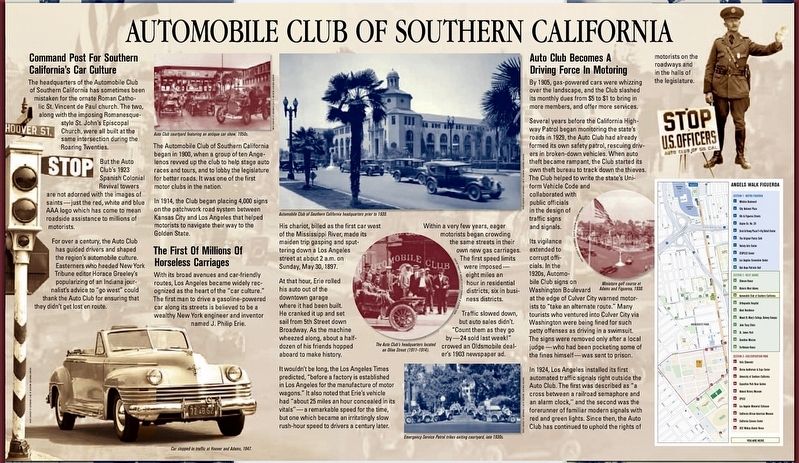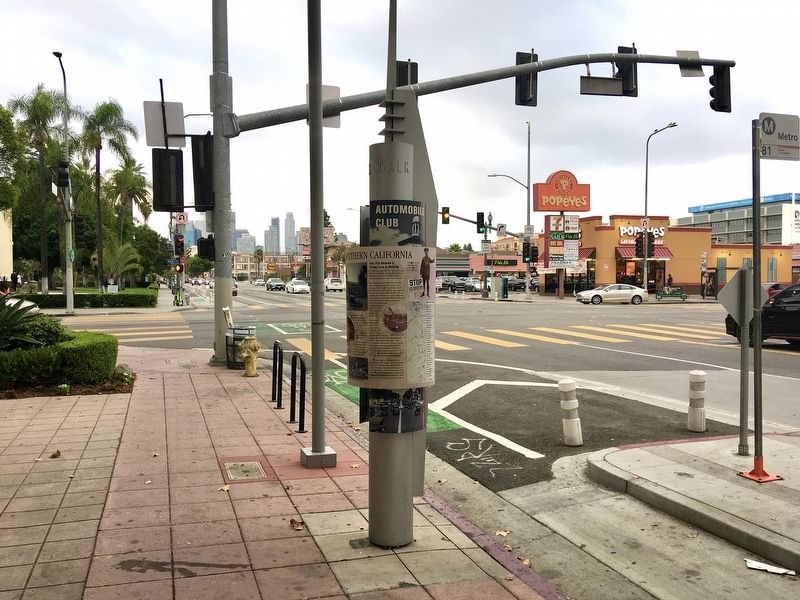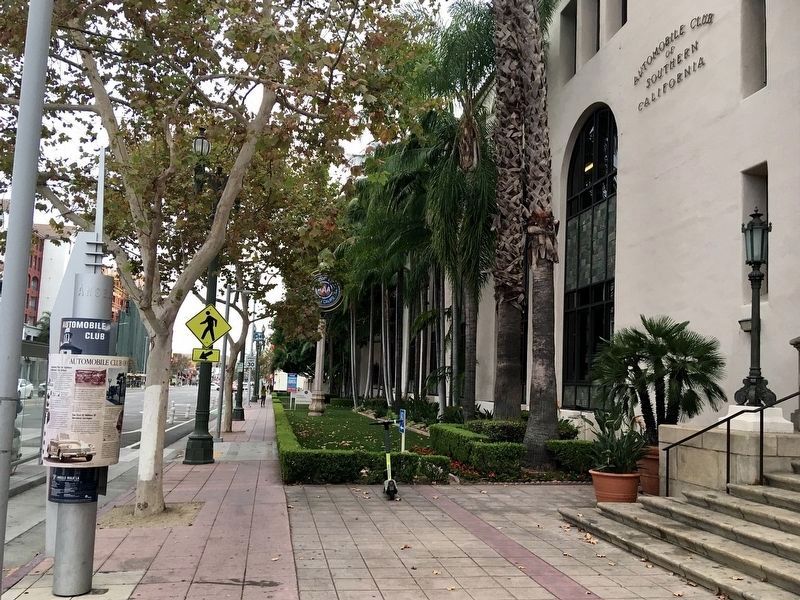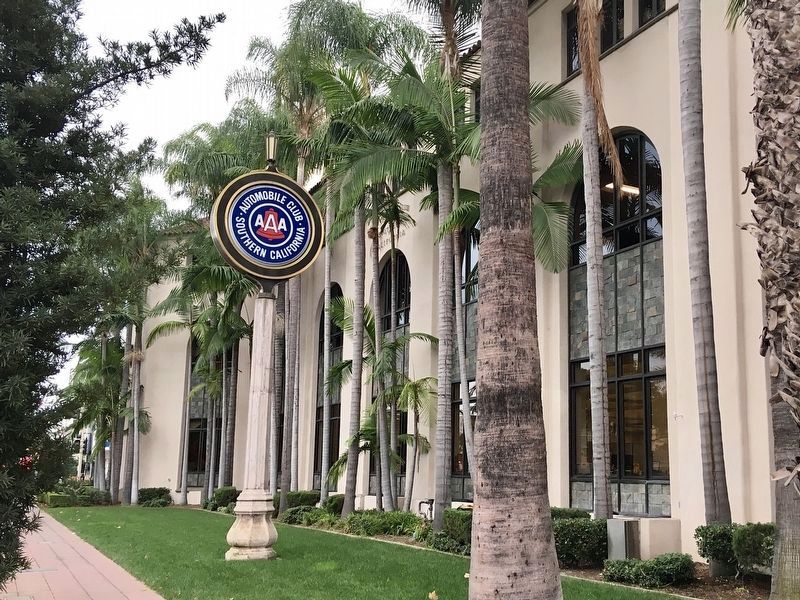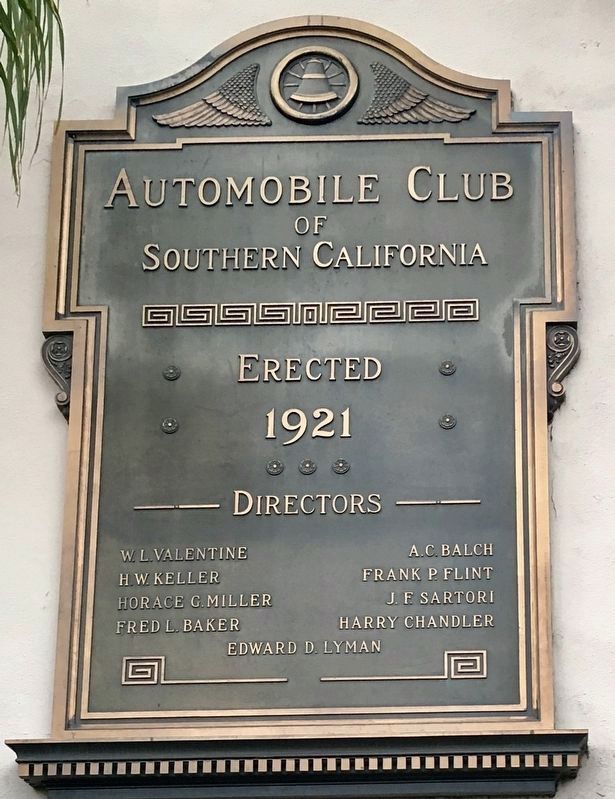South Los Angeles in Los Angeles County, California — The American West (Pacific Coastal)
Automobile Club of Southern California
Command Post For Southern California's Car Culture
The headquarters of the Automobile Club of Southern California has sometimes been mistaken for the ornate Roman Catholic St. Vincent de Paul church. The two, along with the imposing Romanesque-style St. John's Episcopal Church, were all built at the same intersection during the Roaring Twenties.
But the Auto Club's 1923 Spanish Colonial Revival towers are not adorned with the images of saints — just the red, white and blue AAA logo which has come to mean roadside assistance to millions of motorists.
For over a century, the Auto Club has guided drivers and shaped the region's automobile culture. Easterners who heeded New York Tribune editor Horace Greeley's popularizing of an Indiana journalist's advice to "go west" could thank the Auto Club for ensuring that they didn't get lost en route.
The Automobile Club of Southern California began in 1900, when a group of ten Angelenos revved up the club to help stage auto races and tours, and to lobby the legislature for better roads. It was one of the first motor clubs in the nation.
In 1914, the Club began placing 4,000 signs on the patchwork road system between Kansas City and Los Angeles that helped motorists to navigate their way to the Golden State.
The First Of Millions Of Horseless Carriages
With its broad avenues and car-friendly routes, Los Angeles became widely recognized as the heart of the "car culture." The first man to drive a gasoline-powered car along its streets is believed to be a wealthy New York engineer and inventor named J. Philip Erie.
His chariot, billed as the first car west of the Mississippi River, made its maiden trip gasping and sputtering down a Los Angeles street at about 2 a.m. on Sunday, May 30, 1897.
At that hour, Erie rolled his auto out of the downtown garage where it had been built. He cranked it up and set sail from 5th Street down Broadway. As the machine wheezed along, about a half-dozen of his friends hopped aboard to make history.
It wouldn't be long, the Los Angeles Times predicted, "before a factory is established in Los Angeles for the manufacture of motor wagons." It also noted that Erie's vehicle had "about 25 miles an hour concealed in its vitals" — a remarkable speed for the time, but one which became an irritatingly slow rush-hour speed to drivers a century later.
Within a very few years, eager motorists began crowding the same streets in their own new gas carriages. The first speed limits were imposed eight miles an hour in residential districts, six in business districts.
Traffic slowed down, but auto sales didn't. "Count them as they go by — 24 sold last week!" crowed an Oldsmobile dealer's 1903 newspaper ad.
Auto Club Becomes A Driving Force In Motoring
By 1905, gas-powered cars were whizzing over the landscape, and the Club slashed its monthly dues from $5 to $1 to bring in more members, and offer more services.
Several years before the California Highway Patrol began monitoring the state's roads in 1929, the Auto Club had already formed its own safety patrol, rescuing drivers in broken-down vehicles. When auto theft became rampant, the Club started its own theft bureau to track down the thieves. The Club helped to write the state's Uniform Vehicle Code and collaborated with public officials in the design of traffic signs and signals.
Its vigilance extended to corrupt officials. In the 1920s, Automobile Club signs on Washington Boulevard at the edge of Culver City warned motorists to "take an alternate route." Many tourists who ventured into Culver City via Washington were being fined for such petty offenses as driving in a swimsuit. The signs were removed only after a local judge — who had been pocketing some of the fines himself — was sent to prison.
In 1924, Los Angeles installed its first automated traffic signals right outside the Auto Club. The first was described as "a cross between a railroad semaphore and an alarm clock," and the second was the forerunner of familiar modern signals with red and green lights. Since then, the Auto Club has continued to uphold the rights of motorists on the roadways and in the halls of the legislature.
Erected 2005 by City of Los Angeles.
Topics. This historical marker is listed in these topic lists: Architecture • Roads & Vehicles. A significant historical year for this entry is 1921.
Location. 34° 1.679′ N, 118° 16.579′ W. Marker is in Los Angeles, California, in Los Angeles County. It is in South Los Angeles. Marker is at the intersection of Figueroa Street and Adams Boulevard, on the right when traveling south on Figueroa Street. Touch for map. Marker is at or near this postal address: 2601 S Figueroa St, Los Angeles CA 90007, United States of America. Touch for directions.
Other nearby markers. At least 8 other markers are within walking distance of this marker. St. Vincent de Paul Church (within shouting distance of this marker); Automobile Club Headquarters (within shouting distance of this marker); Historic West Adams (within shouting distance of this marker); St. John's Episcopal Church (about 300 feet away, measured in a direct line); Mount St. Mary’s College (about 800 feet away); Doheny Mansion (approx. 0.2 miles away); Kerckhoff House (approx. 0.2 miles away); John Tracy Clinic (approx. ¼ mile away). Touch for a list and map of all markers in Los Angeles.
Also see . . . Angels Walk L.A. Self-guided walking tours of historic neighborhoods in Los Angeles. The Automobile Club marker is part of the Figueroa walk. (Submitted on October 23, 2022.)
Credits. This page was last revised on July 28, 2023. It was originally submitted on October 23, 2022, by Craig Baker of Sylmar, California. This page has been viewed 219 times since then and 38 times this year. Photos: 1, 2, 3, 4, 5. submitted on October 23, 2022, by Craig Baker of Sylmar, California.
